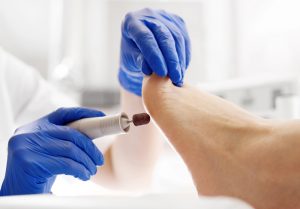5 Easiest Foot Problems to Resolve
Foot problems can be troublesome, but corns/calluses, bunions, athlete’s foot, blisters, and stone bruises can be treated at home.
There are at least 25 commonly diagnosed foot problems. Some are so serious they should be treated only by an orthopaedic surgeon who specializes in foot and ankle disorders or by a doctor of podiatric medicine. Others can be addressed by a primary care physician or by a health care provider at a walk-in care center.
The five foot problems discussed here can be treated at home unless they’re painful or disfiguring enough to affect normal daily activities. We’ll start with corns and calluses, one of the more common foot problems.
Corns and Calluses: What’s the Difference Between These Two Foot Problems?
Corns and calluses affect about 5 percent of people in the United States. Both foot problems involve a thick outer layer of skin, and both can be caused by pressure or by toes rubbing together. They may also result from foot deformities causes by rheumatoid arthritis or misshapen toes.

Calluses on the bottom of the foot sometimes require outside assistance. (Photo: © Robertprzybysz | Dreamstime.com)
The difference is that corns (and there are five types of them) have a core and normally develop on a knobby part of a toe, while calluses are evenly distributed on the soles of the feet. Although some calluses may protect a part of the foot, both corns and calluses can be big enough to cause pain and difficulty in walking.
When they are painful, the goal of treatment is to reduce or eliminate the pressure or friction that causes them. Wear shoes that fit, use pads that cushion the area, and use an over-the-counter product that contains salicylic acid. Curad Mediplast and Dr. Scholl’s Corn and Callus Remover are two trade names. Such products soften the tissue, making it possible to remove the dead skin.
If you have diabetes, peripheral artery disease, or peripheral neuropathy, get medical attention.
Bunions: A Bad Fit
Bunions develop when the joints of the big toe do not fit together as they should and become swollen and tender. If a bunion is not severe, wearing widely cut shoes or pads to cushion the bunion might work. Avoiding activities that require being on your feet for long periods of time reduces the risk. Ice can provide relief from inflammation and pain.
Shoe inserts are another alternative. Doctors might recommend other-the-counter drugs, prescribe anti-inflammatory drugs, or give cortisone shots to relieve the pain.
Less frequently, same-day surgery is needed to relieve pressure and repair the joint. During surgery, bones, ligaments, tendons, and nerves are put back into correct order, and the bump is removed.
Athlete’s Foot: It’s Not Just for Athletes
Bacterial and fungal infections—including athlete’s foot—develop because feet spend a lot of time in the perfect breeding ground of warm, dark, humid shoes.
You’ll recognize the symptoms of redness, small blisters, itching, and peeling. Once these infections develop, they are hard to cure. Prevent them by keeping your feet clean and dry. Wear wicking acrylic or cotton socks. Change shoes, socks, or stockings often and use foot powder daily. If things don’t get better within two weeks, see your doctor.
Blisters: Don’t Drain Them
Blisters are usually caused by friction. They’re actually small pockets filled with fluid that develop on the upper layer of skin, which is trying to protect itself.
Treatment begins by covering the blister with a bandage. If the blister is in an area of the foot that can be protected, use padding to protect it. Cut the padding into a donut shape with a hole in the middle, then place it around the blister. Cover the padding with a bandage.
Avoid popping or draining a blister, if possible. It could lead to infection.
If a blister is large and painful, sterilize a small needle with rubbing alcohol, pierce the edge of the blister, and allow some of the fluid to drain.
Here are some tips from the American Academy of Dermatology for protecting your feet from blisters.
- Wear nylon or moisture-wicking socks.
- Try wearing two pairs of socks.
- Make sure your shoes fit properly—not too tight or too loose.
- Use powder or petroleum jelly to reduce friction when your skin rubs together or against shoes.
- Stop an activity immediately if you experience pain or discomfort or your skin turns red.
10 TIPS FOR FOOT HEALTH
Most of the foot problems just described can be avoided. These tips can help in maintaining healthy feet.
- Inspect your feet regularly.
- Maintain good foot hygiene.
- Hydrate the skin with lotions or creams.
- Buy shoes that are comfortable without a “breaking in” period.
- Cut toenails straight across.
- Exercise—walk—every day.
- Avoid walking barefoot.
- Alternate shoes daily so they can dry out.
- Buy shoes later in the day when your feet have expanded.
- Avoid pointed-toe styles and high heels.
Stone Bruise: Feeling the Pain
A stone bruise is a painful, inflammatory condition on the bottom, forefoot area (the ball of the foot). It could be caused by an injury, overuse, or a structural defect.
The pain increases over time and usually becomes noticeable when walking. It is typically described as a burning or stabbing sensation. You’ll experience more pain when the toes are pulled upwards or when the joints are pressed.
Home treatment includes rest, ice, compression, and elevation (RICE). Changing shoes might help, especially for women who wear high heels. If symptoms don’t subside within a week, contact your primary care physician or a podiatrist.


 MGH Study: Hot Yoga May Help Ease Depression Symptoms, but Be Mindful of Health Concerns
MGH Study: Hot Yoga May Help Ease Depression Symptoms, but Be Mindful of Health Concerns  Ramsay Hunt Syndrome
Ramsay Hunt Syndrome 
Dozens of conditions—serious and not-so-serious—can affect our feet. Here, we focus on five foot problems you can tend to (mostly) at home.
© Robertprzybysz | Dreamstime.com